WAVES during World War II
.
The Women's Reserve of the United States Naval
Reserve was created by an act of Congress on July 30, 1942.
This act was designed to appoint and enlist
women as a necessary wartime emergency measure, in order to replace men
who could thereby be released for active sea duty in the deployed operational
forces and seagoing fleet.
Although the WAVES were only an "experiment",
favorable results for Navy efficiency became immediately apparent. |
... |
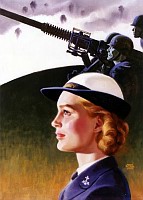 |
.
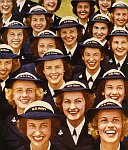 |
....... |
During 1942, the Navy Department was especially
pleased that female volunteers enrolled in numbers three times that expected
during the legislative debates.
This help multiplied the number of shore-based
male sailors who could be released for fleet service. |
.
| Large numbers of women were first assigned
to maintain the Navy communications system.
As WAVES strength increased, entire staffs
of men at land-based stations disappeared because women took over airfield
control towers, manned vital naval communications networks, and served
important roles in health and hospital work. |
..... |
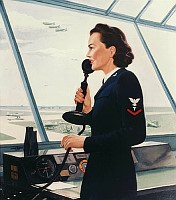 WAVE Air Traffic Controller
WAVE Air Traffic Controller
|
.
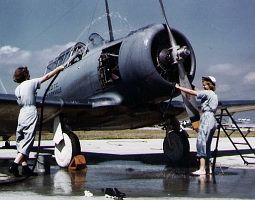 Two WAVES washing a North
American SNJ training plane
Two WAVES washing a North
American SNJ training plane
|
..... |
Furthermore, women were being trained for
jobs in gunnery and blind flying instruction, aerology, aviation ground
crew work, navigation and other fields.
The Navy estimated that these women of 1942
freed enough men to outfit an entire task force composed of 1 battleship,
2 large aircraft carriers, 2 heavy cruisers, 4 light cruisers and 15 destroyers. |
.
The year 1943 witnessed the placement of needed
WAVES into yet more billets once exclusively reserved for men.
.
In November 1943, Congress provided legislation
that removed its former limitations placed on female officer ranks.
.
During September 1944, further Congressional
legislations permitted WAVES to volunteer for duty outside the mainland
United States. Within a month, WAVES were being deployed overseas. On January
6, 1945, the first major contingent of enlisted WAVES arrived via troop
transport ship at Pearl Harbor, Hawaii. |
....... |
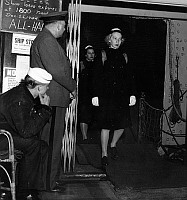
WAVES come aboard the transport
that will take them to Pearl Harbor, Hawaii in December 1944
|
.
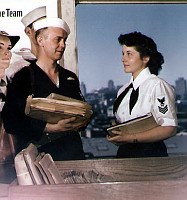
Picking up mail at the Fleet
Post Office, San Francisco, California |
..... |
Throughout 1944, the “experiment” of using
women proved sound policy for the United States war effort. WAVES responsibilities
were again increased.
By now, female personnel were posted to district
headquarters, navy yards and docks, supply depots, naval air stations,
and all naval hospitals. Nearly 80 percent of all administrative work was
being done by WAVES, to include supervising and running the entire naval
mail service. |
.
| Furthermore, the vital Washington-based naval
communications nerve center was comprised of 75 percent WAVES.
Thousands of WAVES were assigned to the Supply
Corps, where they expedited wartime supplies to ships and to advanced overseas
bases.
These women served as officers, storekeepers,
yeomen, and seamen who kept critical naval logistics flowing to the front. |
...... |
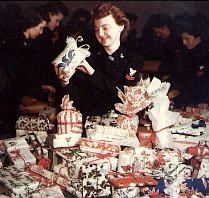
WAVES of the Bureau of Supplies
and Accounts help wrap Christmas presents for Navy and Marine Corps convalescents
|
.
Women were placed by the Navy in both mundane
and dangerous activities. For instance, WAVES operated all the laboratories
and many of the firing bays at the crucial Indian Head rocket powder plant,
which conducted most testing of American rocket propellants. There they
composed nearly half the personnel assigned to this critical facility.
.
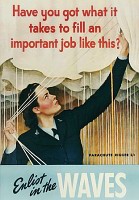 |
...... |
As many as a third of all WAVES were assigned
to naval aviation. In this field, women fixed aircraft, packed parachutes,
provided weather information, served as link trainer instructors, served
as gunnery instructors, coordinated air traffic from control towers and
a performed host of other aviation-related jobs. |
.
In keeping with the racist policy of the US
government, the Navy denied black women service in the WAVES during most
of the war. However, McAfee, the Women's Advisory Council and black
women leaders kept pressure on the Navy Department and continuously demanded
that black women be permitted to serve on a fully integrated basis.
No action was taken for over two years until First Lady Eleanor Roosevelt,
wife of President Franklin D. Roosevelt, joined this effort. Her direct
interest forced the Navy to open its WAVES program to qualified Black applicants.
.
Finally, in October 1944, the Navy announced
the plan to commission black women (who nevertheless had to possess super-qualified
credentials) and to put the first enlisted black women into training by
January 1, 1945. Harriet Ida Pickens and Frances Wills became the Navy's
first African-American WAVES officers in December 1944. Seventy-Two black
women enlisted and started their training at Hunter College. Their ability
set the precedent for later successful integration of black men.
.
First Lady Eleanor Roosevelt was still forced
to intervene against the Navy to force fair treatment within the WAVES
during the war. For example, her active intervention was required
before naval bases allowed Jews and Blacks in the WAVES to use recreational
facilities. |
... |
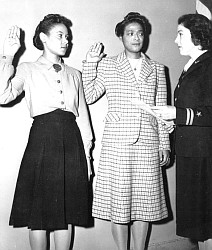 Frances Wills (left) and
Harriet Ida Pickens are sworn in as Apprentice Seamen at New York City
in November 1944.
Frances Wills (left) and
Harriet Ida Pickens are sworn in as Apprentice Seamen at New York City
in November 1944.
|
.
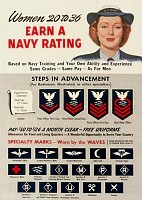 |
...... |
During the final war year of 1945, enlisted
women could choose from a total of 38 different ratings in the Navy. Almost
every shore establishment had WAVES on active duty fulfilling necessary
military work of every kind, from general office workers and supply accounts
specialists to film projectionists and drivers to dental prosthetic technicians.
Within the Navy Department headquarters at Washington, D.C., over half
(55 percent) of all service personnel were WAVES. |
.
| As another example, 70 percents of the Bureau
of Naval Personnel was composed of WAVES.
Large numbers of WAVES were assigned to the
Hospital Corps where they participated in Navy recovery, therapy and rehabilitation
programs. |
...... |
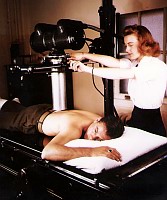 WAVE prepares to X-Ray
WAVE prepares to X-Ray
|
.
The termination of World War II for the United
States was achieved by its triumph over Japan on August 17, 1945. This
was also the end of further WAVES procurement, since the military use of
women as an “emergency” measure ended with the coming of peace. The ranks
rapidly diminished and no new WAVES were accepted. By September of 1946,
the majority of WAVES were either discharged or released to inactive duty.
.
.
[ I. Development ]..[
II. Facts about the WAVES ]..[
III. Uniforms ]..[
IV. Sources ]
|
